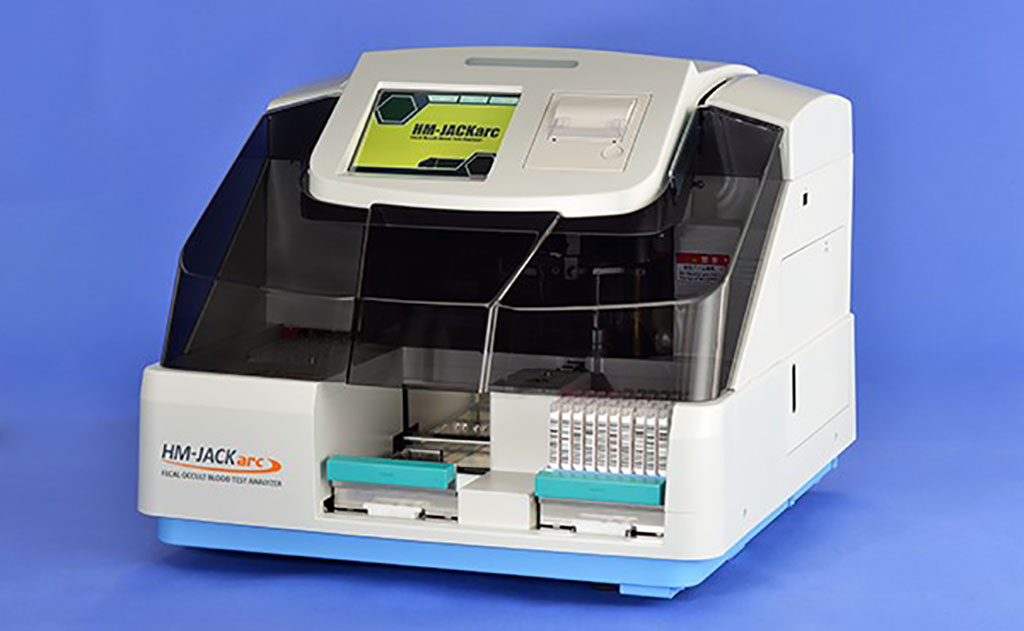Fecal Immunochemical Test Assessed in Suspected Colorectal Cancer
By LabMedica International staff writers
Posted on 05 Nov 2020
Colorectal cancer (CRC), also known as bowel cancer, colon cancer, or rectal cancer, is the development of cancer from the colon or rectum (parts of the large intestine). Signs and symptoms may include blood in the stool, a change in bowel movements, weight loss, and fatigue.Posted on 05 Nov 2020
The fecal immunochemical test (FIT) detects the globin component of hemoglobin (Hb) by immunoassay and can reliably measure the fecal Hb concentration (f-Hb) to the nearest microgram of Hb per gram of faces (µg/g). Since 2010, over 25 diagnostic accuracy studies have reported data on the use of FIT in symptomatic patients utilizing a range of cut-offs.

Image: The HM-JACKarc analytical system is a compact bench top system that uses Integrated Sphere Latex Turbidimetry to measure fecal hemoglobin concentration using a highly sensitive latex reagent coated with polyclonal antibodies to human hemoglobin (Photo courtesy of Hitachi Chemical Diagnostics Systems).
A team of medical scientists led by those at Croydon University Hospital (Croydon, UK) analyzed almost 10,000 patients referred to a specialist for suspected CRC symptoms that met criteria for urgent care. FIT sensitivity was maximized to 97.0% at the lowest fecal hemoglobin concentration cutoff of 2 µg/g. Between October 2017 and December 2019, 21,126 patients were sent recruitment packs, 13,219 (62.6%) returned FIT devices. Complete FIT and colonoscopy outcomes were available for 9,822 patients, who were included in the study results. Median age was 65 in the final cohort of kit-returning patients, 54% of whom were women.
FIT analysis was performed at one centralized laboratory where staff were blinded to patient clinical information. The HM-JACKarc analytical system (Hitachi Chemical Diagnostics Systems, Tokyo, Japan) was used to analyze all samples. The analytical working range is 7–400 µg/g. The limit of detection (LoD) of the assay is 2 µg/g and the limit of quantitation is 7 µg/g. The National Institute for Health and Care Excellence (NICE) recommended an f-Hb cut-off of 10 µg/g in the DG30 guidelines. Colonoscopy was chosen as the reference standard since it is acknowledged to be the gold-standard investigation for colorectal disease. Colonoscopists were blinded to the FIT results.
The team reported that incidence of CRC at colonoscopy was 3.3%. At fecal hemoglobin concentration cutoffs of 2, 10, and 150 µg/g, FIT positivity decreased from 37.2% to 19.0% and 7.6%, respectively. The positive predictive values of FIT for CRC was 8.7% at the 2 µg/g cutoff, 16.1% at the 10 µg/g cutoff, and 31.1% at the 150 µg/g cutoff. Respective negative predictive values were 99.8%, 99.6%, and 98.9%. In terms of sensitivity for CRC, this decreased from 97.0% at the 2 µg/g cutoff, to 90.9% at the 10 µg/g cutoff, and 70.8% at the 150 µg/g cutoff. Specificity increased from 64.9% to 83.5% and 94.6%, respectively.
The authors concluded that a higher hemoglobin cutoff could be set to match capacity in resource-limited settings, which would reduce the number of positive results, onwards referral for investigation and demand for colonoscopy but at the expense of detecting fewer cancers. The study was published on October 21. 2020 in the journal GUT.
Related Links:
Croydon University Hospital
Hitachi Chemical Diagnostics Systems




 assay.jpg)








